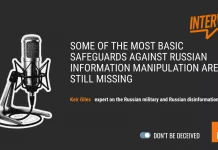Galina Timchenko, a Russian journalist and a former chief editor of the portal Lenta.ru, created the following instructions, which were published in the magazine “Afisha.”
1.
Don’t believe headlines. They are written to attract your attention and usually do not have any serious meaning. Regularly, a headline contradicts the content of the article…
2.
Verify verbs in a headline and in the first paragraph, since these are the places that contain crucial information. If a headline reads “Foreign movies will be banned in Russia”, then you are most likely to find out that only one official proposed such an initiative.
3.
If a headline and content of an article contradict each other, examine the third and the fourth paragraph – that is where the “main character” will appear (an individual, for the sake of whom this article was written, or a “customer”). His or her [“customer’s”] opinion will be quoted.
4.
Pay attention to the source of the news. If a news article does not contain a source at all, you have a reason to doubt the authenticity of information. If a publisher cites in a news article another newspaper or a news resource as a source of information, then do not be lazy and click the internet link to make a comparison.
5.
If a newspaper confidently reports the news, but all interviewed participants involved in it do not comment or deny the news, then you have a reason to suspect this newspaper in “dumping” – publishing unverified information, rumors, which are being injected with a certain purpose.
6.
News is an event which has already occurred. If a news article begins with a strong statement about an inevitability of a certain event in the future (ecological catastrophe, epidemic, etc), then this means that you are reading anything but a “horror story.”
7.
On experts. Before listening to their opinion, you should type their name in any search engine and check, whether this expert has anything to do with the problems described in a news article.
8.
Every news story has details. T here can be few details, but they are always present: address, time of event, involved participants, circumstances of the case. And there should not be any emotions. Use of epithets is an alarming signal for a reader about the lack of facts in the article.
Source: Rustem Adagamov.





